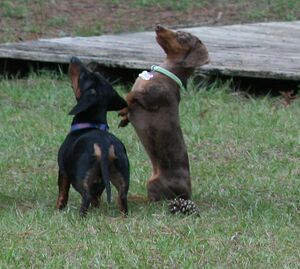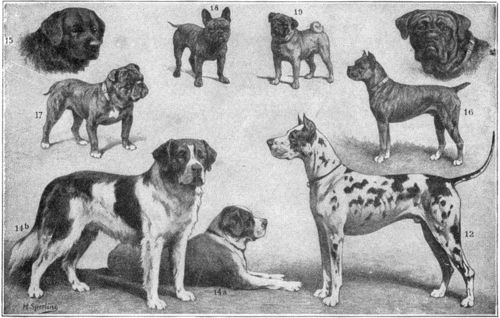Dog breed: Difference between revisions
imported>Nancy Sculerati MD |
imported>Peter Lacey m (Dog breed moved to Dog breed ON WHEELSS!!!: Long Live Wikipedia!) |
(No difference)
| |
Revision as of 12:02, 16 February 2007
A dog breed is a group of dogs that share a set of very similar features, including a characteristic appearance and behavior. The attributes that make a certain breed recognizeable as that breed are written into a formal "breed standard" by kennel clubs. Some breeds are defined primarily by their ability to do a job, like hunt, herd - or fight. Other breeds are more strictly defined by their appearance. Appearance is what dog breeders call "conformation", and includes such details as the exact proportions of the snout, the color of the coat, and the set of the tail. No matter how much the appearance of an animal differs from one dog breed to the next, all dogs are the same species, [[Canis familiaris]]. That means that all fertile dogs are capable of mating with each other and producing puppies. If a breed "breeds true", then the progeny of two parents of a single breed will produce pups that share the breed characteristics.
Of course, everything that distinguish one breed of dogs from another does so in the minds of humans, not dogs. Each named breed of dog fits some human image of a particular variety of canine. Despite that, not all dog breeds were bred by people. Some came about because a group of domestic dogs were isolated from other dogs by geographic barriers, and over the generations produced progeny that were all, or mostly, of a recognizeable type. These breeds, called natural breeds, often originated in mountainous areas or islands. If they had qualities that people found attractive or useful, such distinctive dogs were further bred by fanciers using artificial selection- that is, puppies were born to females whose mates were chosen by the breeders, rather than left up to the dogs. An example of a dog breed that is the result of both natural selection in an isolated area and selective breeding by dog fanciers is the Newfoundland.
"The archeologic record suggests that the first domestic dogs are found in the Middle East approximately 14,000 years ago".(reference for quote:Robert K. Wayne, Elaine A. Ostrander: Origin, genetic diversity, and genome structure of the domestic dog BioEssays Volume 21, Issue 3, Date: March 1999, Pages: 247-257). There is every reason to believe that selectively bred for specific characteristics has occured for thousands of years.
However long people have been breeding dogs, most of the current dog breeds have only been around for the last hundred years. In the 1870's kennel clubs were founded and kept records of breeds, setting breed standards and registering individual dogs. Those animals with "papers" from the breed registries are said to be "purebred". In dogs, only individuals whose mother and father are both registered members of the breed are able to be registered, and considered purebred. This concept has caused controversy both because of the difficulty of regulation and because of the possible genetic consequences of a limited population (inbreeding). Recent work has been done to genetically classify the various breeds, with some surprising results regarding the estimated age and interrelations of the breeds.
History of dog breeds
It's easy to forget that until the industrial revolution brought us machines, animals were responsible for a great deal of labor. Although there are still working dogs on the job, the routine place of a dog among people in past generations was as some kind of worker. Almost all of the known breeds from ancient times were specialized for some sort of job.

Ancient history
Kennel Clubs: Conformational shows and field trials
Recognizing a new breed
The point at which a new variety becomes a breed can be difficult to decide. National kennel clubs often differ in their recognition of breeds and rare breeds might not be recognised outside their home country. Usually, only dogs recognized by a kennel club are eligible to compete in that specific club's conformation shows and dog sports, although many dog sports allow any healthy dog to compete regardless of the breed.
Generally, before a type of dog is recognized as a breed, it must be shown that mating a pair of that type always produces dogs that have the same characteristics as the parents, usually both in appearance and in behavior. This is known as breeding true. There are many issues concerning what is considered breeding true. For example, Flat-Coated Retrievers must always be black; however, yellow coats occur occasionally in some litters. Kennel clubs do not recognize the yellow dogs as legitimate members of the breed; some breeders will kill the puppies rather than risk having the dog grow up, breed, and produce more of the undesired yellow color, perpetuating the undesireable gene; more often, today, such dogs are neutered and placed in homes as pets. As another example, a breeding pair of Belgian Shepherds of the Groenendael variety can produce puppies of the Tervueren (brown) variety; the AKC considers the varieties to be different breeds and, therefore, the brown puppies are invalid and undesirable dogs, whereas the CKC considers them simply to be different color varieties of the same breed.
See selective breeding for a detailed discussion on open versus closed stud books and some of the issues concerning purebreds.
Working Breeds
Livestock Guard Dogs
These dogs have been used by people who depend on livestock for economic reasons to protect their domestic herd animals from predators. Such dogs do not herd animals but do defend them. Livestock Guardians are large and powerful enough to deter local predators, including human thieves and therefore are generally massive dogs that are potentially very aggressive. Such breeds include the Anatolian Shepherd Dog,XXXX.
The problem of evaluating dog intelligence is raised by dogs bred to protect livestock in the field. Some of these animals are known to be extremely capable at thwarting attacks on their herds of sheep and other livestock, but rather reluctant to respond to human commands. In fact, the ability to act independantly is what makes such a dog an effective gaurdian, and arguably is a sign of intelligence. However, a more obediant dog or obeys commands instantly is liable to score higher on most of the standard means to evaluate the intelligence of dogs.
Terriers
Terriers share a certain general body type and disposition. Many breeds of terrier (such as the Rat Terrier originated as working dog dedicated to rodent patrol on farms and in rural households. Other terriers were bread for fighting.
See also
Further reading
D. Caroline Coile Ph.D. : Encyclopedia of Dog Breeds . Second Edition.2005

